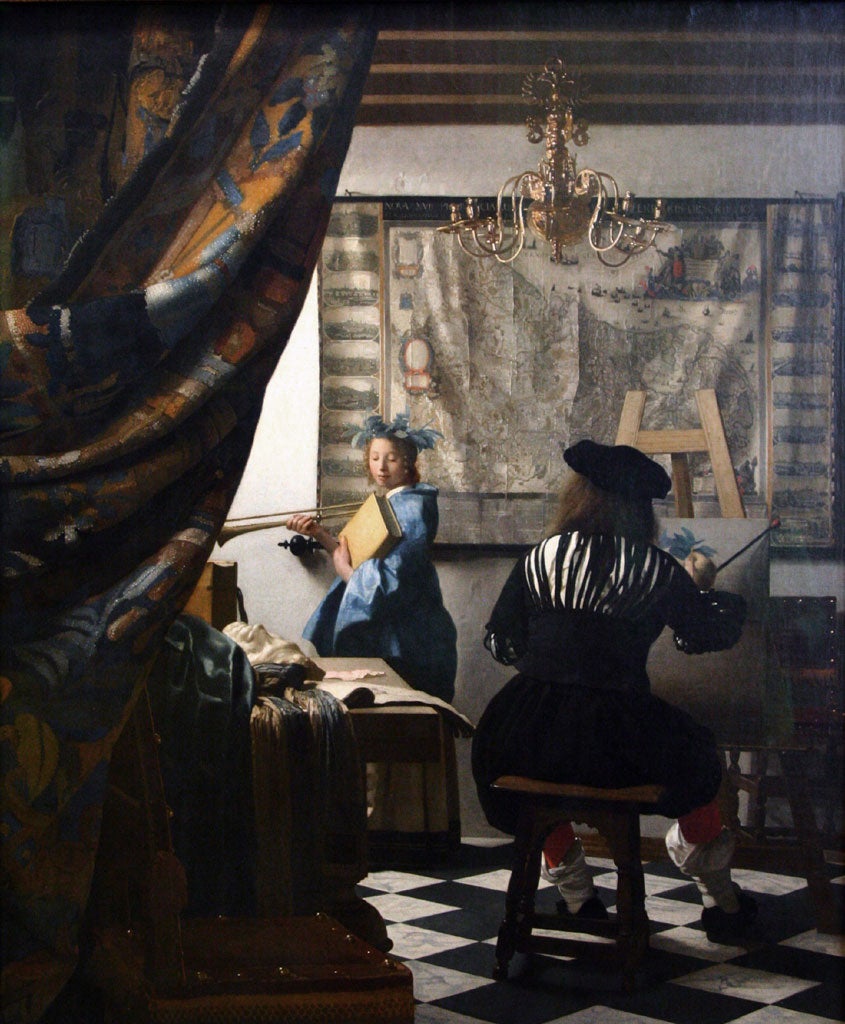Great Works: The Art of Painting, circa 1666-7 (120cm x 100cm), Johannes Vermeer
Kunsthistorisches Museum, Vienna

Your support helps us to tell the story
From reproductive rights to climate change to Big Tech, The Independent is on the ground when the story is developing. Whether it's investigating the financials of Elon Musk's pro-Trump PAC or producing our latest documentary, 'The A Word', which shines a light on the American women fighting for reproductive rights, we know how important it is to parse out the facts from the messaging.
At such a critical moment in US history, we need reporters on the ground. Your donation allows us to keep sending journalists to speak to both sides of the story.
The Independent is trusted by Americans across the entire political spectrum. And unlike many other quality news outlets, we choose not to lock Americans out of our reporting and analysis with paywalls. We believe quality journalism should be available to everyone, paid for by those who can afford it.
Your support makes all the difference.In its making, this painting is utterly characteristic of the mature Vermeer: admire the warmth and the moistness, if not the butteriness, of the light; the different weight and tactile force of the colours, shifting from soft and yielding through to hard-edged; the lovely, almost seemingly effortless, manipulation of perspective; and the way he has organized objects and people within the space of the painting – to such an extent that what we are looking at almost has an air of inevitability about it. And yet it offers a little something extra too, this painting, something we meet less frequently in this artist's work. Is there not just a gentle touch of self-conscious panache, and even of swagger, in that title, which causes us both to look at what is in front of our eyes – and go on looking and looking at this inexhaustible scene – and to step back and admit to ourselves that this is both a painting and a reflection upon what the art of painting, when practised at this level of achievement, actually consists of, what the art of illusionism – and what the art of history painting, that most exalted of genres – really mean?
It is several paintings in one then. It is both a rather touching domestic scene with a tiny, wheedling underground stream of eroticism (look at the painter's raring red hose, and admire his bulking, almost bull-like presence when seen from behind), and a history painting, executed at a very significant moment in the history of the young Dutch Republic, which poses as an allegory of some importance. It is a third thing too. It is a painting of our witness to the making of such a painting. We are spectators, are we not, in this impromptu studio? The tapestry has just been yanked aside to admit us to this rather private scene, which enables us to observe a painter who is creating a history painting.
We are also seeing much more than this though. We privileged viewers are observing the entire context in which this painter is working, so you could say that the theme within a theme – the making of a history painting whose subject matter is Clio, the muse of history, which we just about glimpse beginning to emerge on the painter's canvas – is only a part of this painting's whole. Yes, we are being treated to a scene that encompasses the making of a history painting, but the history-painting-in-the-making whose creation we are witnessing is much less than the painting we are staring at. Much will be absent from that small scene. That scene will not, for example, take in most of the map, which alludes to the liberation of the Northern Provinces from Spanish domination. This was relatively new history when Vermeer was painting this scene. Neither will it encompass that chandelier, with its twin Hapsburg-like eagles – yet another pointed historical allusion. See what those Hapsburgs have been reduced to these days, those eagles seem to say to us. Are they not as swingeingly powerful as decorative details on a chandelier? So our history painting – as opposed to the one that has been commissioned from this painter with his back to us – is much fuller and more pleasingly detailed than this representation of Clio herself is ever likely to be.
So, thematically speaking, this painting is both large and small – or, depending upon your point of view, large and yet larger still, because small paintings can be very large indeed. It is a lovely and quite intimate domestic scene, with a touchingly gauche and shy young lady – admire the downturn of those eyes – tricked out to represent a personage as significant as Clio. Look at her laurel crown, balanced just a touch precariously (we see it again, as if to emphasise its importance, as we peer over the painter's shoulder), the trumpet that she clasps in her right hand, and that almost comically unwieldy book. The painting is not finished, of course. It will never be finished. History – like a painting – is only ever in the making.
ABOUT THE ARTIST
Johannes Vermeer (1632-75) of Delft, painter and art dealer, was little appreciated during his lifetime. Now his paintings are among the most prized of all. He seems to intensify our visual appreciation of the world of the domestic interior, to raise up the humdrum to an exquisite pitch.
Join our commenting forum
Join thought-provoking conversations, follow other Independent readers and see their replies
Comments